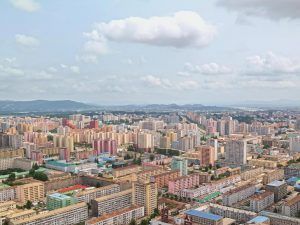Lena Schipper in The Economist:
 Visitors to Pyongyang, North Korea’s capital, often report feeling as though they have landed in a Truman-Show-type setup, unable to tell whether what they see is real or put there for their benefit, to be cleared away like props on a stage once they have moved on. The recent transformation of Kim Jong Un, the country’s dictator, from recluse to smooth-talking statesman has heightened interest in the country but not really shaken the fundamental sense of bewilderment when trying to make sense of it. Oliver Wainwright, the Guardian’s architecture critic (and the brother of The Economist’s Britain editor), who has compiled his photographs from a week-long visit to Pyongyang in 2015 into a glossy coffee-table book published by Taschen, starts from this initial sense of strangeness. He describes wandering around Pyongyang as moving through a series of stage sets from North Korean socialist-realist operas, where every view is carefully arranged to show off yet another monument or apartment building. But his eye is also alive to what the city, which was originally planned by a Soviet-trained architect, has in common with other places that were influenced by Soviet aesthetics.
Visitors to Pyongyang, North Korea’s capital, often report feeling as though they have landed in a Truman-Show-type setup, unable to tell whether what they see is real or put there for their benefit, to be cleared away like props on a stage once they have moved on. The recent transformation of Kim Jong Un, the country’s dictator, from recluse to smooth-talking statesman has heightened interest in the country but not really shaken the fundamental sense of bewilderment when trying to make sense of it. Oliver Wainwright, the Guardian’s architecture critic (and the brother of The Economist’s Britain editor), who has compiled his photographs from a week-long visit to Pyongyang in 2015 into a glossy coffee-table book published by Taschen, starts from this initial sense of strangeness. He describes wandering around Pyongyang as moving through a series of stage sets from North Korean socialist-realist operas, where every view is carefully arranged to show off yet another monument or apartment building. But his eye is also alive to what the city, which was originally planned by a Soviet-trained architect, has in common with other places that were influenced by Soviet aesthetics.
When I first went to Pyongyang earlier this year, the pastel-hued tower blocks, the streetlight fittings shaped like blossom and the interiors decked out in retro colour schemes all seemed strangely familiar. I realised they reminded me of a mid-century-era theme park I’d visited as a child – it has long since closed down – on an island in east Berlin, where people crossed artificial lakes in swan-shaped pedal boats against the backdrop of a ferris wheel with ice-cream-coloured pods. It was only the parade-ready avenues, the enormous bronze statues of the great leaders and the giant monuments to the Workers’ Party and the country’s “Juche” ideology, that gave the game away that we were in the capital of a hereditary totalitarian dictatorship.
More here.
